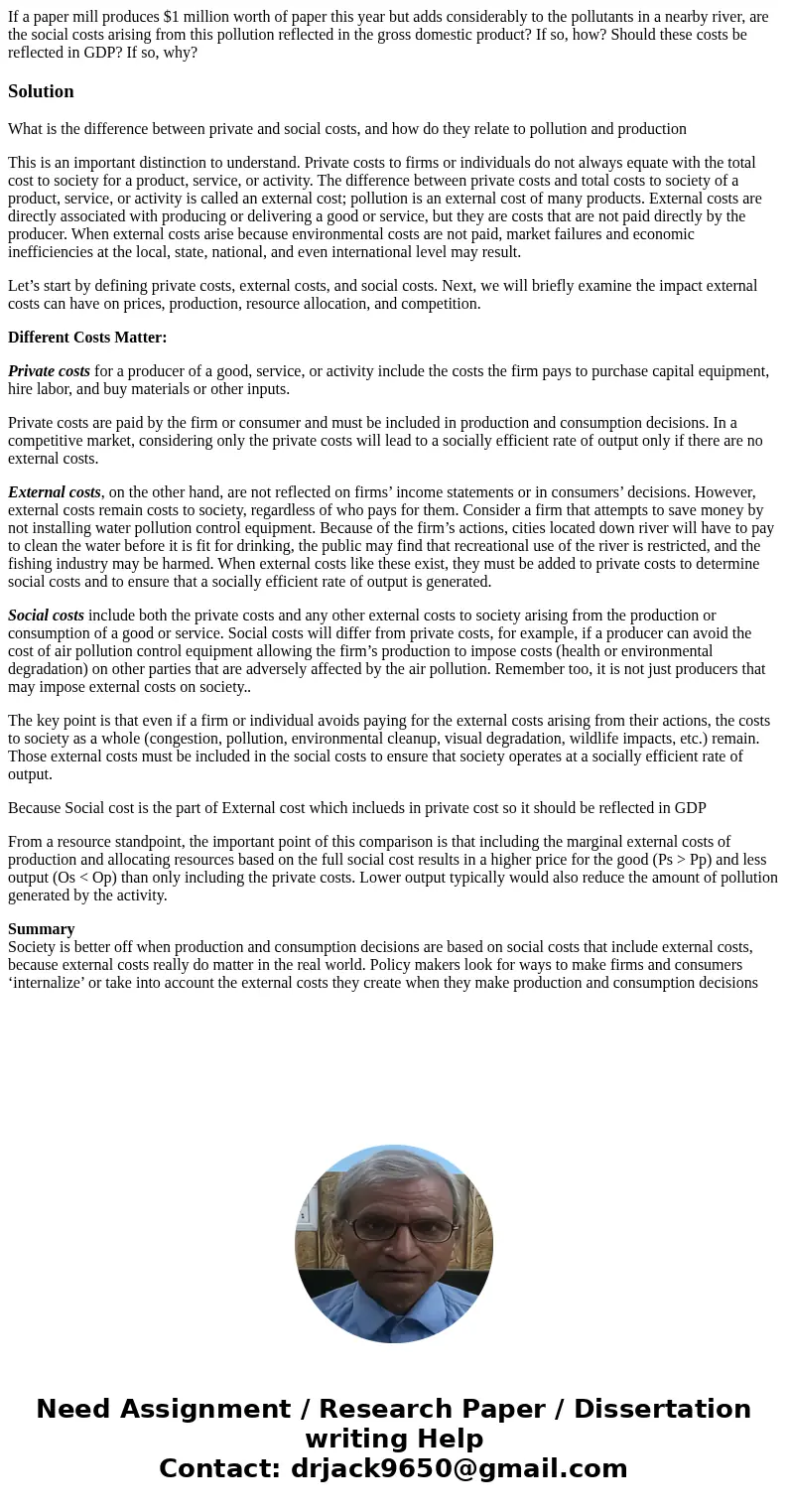If a paper mill produces 1 million worth of paper this year
If a paper mill produces $1 million worth of paper this year but adds considerably to the pollutants in a nearby river, are the social costs arising from this pollution reflected in the gross domestic product? If so, how? Should these costs be reflected in GDP? If so, why?
Solution
What is the difference between private and social costs, and how do they relate to pollution and production
This is an important distinction to understand. Private costs to firms or individuals do not always equate with the total cost to society for a product, service, or activity. The difference between private costs and total costs to society of a product, service, or activity is called an external cost; pollution is an external cost of many products. External costs are directly associated with producing or delivering a good or service, but they are costs that are not paid directly by the producer. When external costs arise because environmental costs are not paid, market failures and economic inefficiencies at the local, state, national, and even international level may result.
Let’s start by defining private costs, external costs, and social costs. Next, we will briefly examine the impact external costs can have on prices, production, resource allocation, and competition.
Different Costs Matter:
Private costs for a producer of a good, service, or activity include the costs the firm pays to purchase capital equipment, hire labor, and buy materials or other inputs.
Private costs are paid by the firm or consumer and must be included in production and consumption decisions. In a competitive market, considering only the private costs will lead to a socially efficient rate of output only if there are no external costs.
External costs, on the other hand, are not reflected on firms’ income statements or in consumers’ decisions. However, external costs remain costs to society, regardless of who pays for them. Consider a firm that attempts to save money by not installing water pollution control equipment. Because of the firm’s actions, cities located down river will have to pay to clean the water before it is fit for drinking, the public may find that recreational use of the river is restricted, and the fishing industry may be harmed. When external costs like these exist, they must be added to private costs to determine social costs and to ensure that a socially efficient rate of output is generated.
Social costs include both the private costs and any other external costs to society arising from the production or consumption of a good or service. Social costs will differ from private costs, for example, if a producer can avoid the cost of air pollution control equipment allowing the firm’s production to impose costs (health or environmental degradation) on other parties that are adversely affected by the air pollution. Remember too, it is not just producers that may impose external costs on society..
The key point is that even if a firm or individual avoids paying for the external costs arising from their actions, the costs to society as a whole (congestion, pollution, environmental cleanup, visual degradation, wildlife impacts, etc.) remain. Those external costs must be included in the social costs to ensure that society operates at a socially efficient rate of output.
Because Social cost is the part of External cost which inclueds in private cost so it should be reflected in GDP
From a resource standpoint, the important point of this comparison is that including the marginal external costs of production and allocating resources based on the full social cost results in a higher price for the good (Ps > Pp) and less output (Os < Op) than only including the private costs. Lower output typically would also reduce the amount of pollution generated by the activity.
Summary
Society is better off when production and consumption decisions are based on social costs that include external costs, because external costs really do matter in the real world. Policy makers look for ways to make firms and consumers ‘internalize’ or take into account the external costs they create when they make production and consumption decisions

 Homework Sourse
Homework Sourse